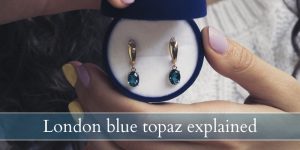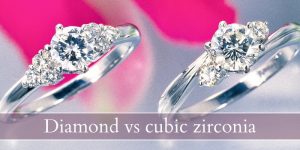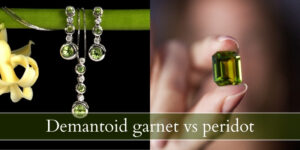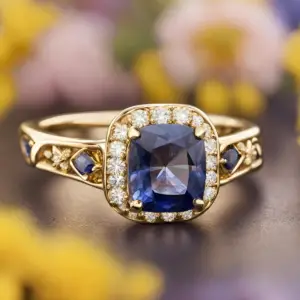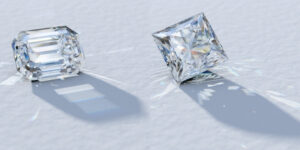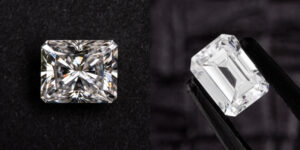Blue gems are definitely some of the coolest and most sought-after gems, and they have one leading gem: the blue sapphire. So much so that sapphires are pretty much the only thing you think of when someone says they want or have a blue gemstone in their jewelry. But lately more and more people have started talking about another blue gem, the blue diamond.
So you might be wondering what’s the difference between blue diamonds and sapphires. Or which is the better one between the two. OR whether sapphire is the same thing as a blue diamond ? Let’s take a look at these gems and settle this.
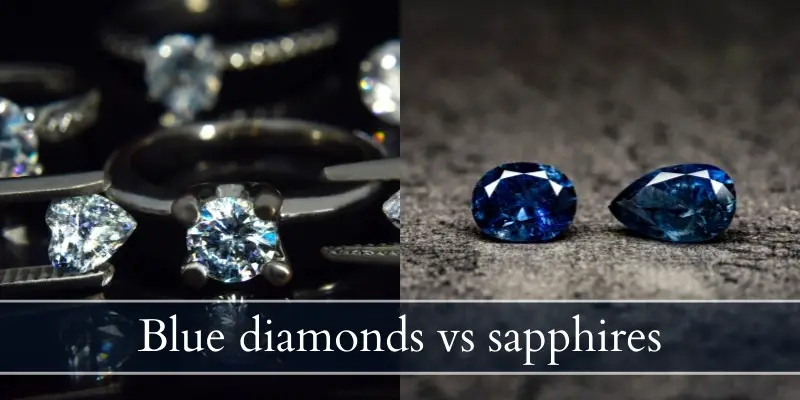
Sapphire vs blue diamond
Sapphires are a deeper, more vivid blue than blue diamonds, and are much cheaper by comparison. Blue diamonds are paler than sapphires and also much tougher, but far more difficult to find at a jeweler. Overall sapphire is the more affordable, more vivid blue gem while diamond is the lighter, sparklier and more expensive blue gemstone.
Both are a great option for jewelry, including engagement rings.
What is sapphire ?
Sapphire is a type of corundum, most commonly blue but it can appear in green, yellow, pink, and orange. Red corundum is always classed as a ruby. So blue sapphires are very well known and they’re very easy to get a hold of since most jewelers carry sapphires as well as diamonds and emeralds. The comparison today will discuss blue sapphires specifically.
Read also: What Gemstones Are Purple ?
What is blue diamond ?
Blue diamonds are a variety of diamond (carbon) that appears blue, usually due to trace amounts of boron. These diamonds are quite rare and make up a small part of the diamond production. Now let’s take a look at blue diamonds compared to blue sapphires, see their key differences and which would be a better fit for you.
1. Blue diamond is tougher than sapphire
Blue diamonds are still diamonds, and as such they are far tougher than a sapphire. Diamonds score a 10 out of 10 on the Mohs scale of hardness. Sapphires are a 9 on the Mohs scale, and despite being just one point lower the difference is that diamonds are about 4-5 times tougher than sapphires. This scale is a bit unbalanced.
But does that mean sapphires shouldn’t be worn on rings or bracelets ? No, you can wear sapphires however you want and they will stand up to wear and tear beautifully. These gems are still incredibly tough, so it’s very difficult to scratch or chip them unless you use something stronger, like a diamond or moissanite.
Diamonds are diamonds, and they will no scratch or break no matter what. Because of this, a blue diamond can be passed down several generations and still look as gorgeous as they day it was first presented. SO both sapphire and blue diamond are very resilient, it’s just that diamond is stronger.
2. Sapphire is a more vivid, deeper blue than blue diamond
When you’re looking for a blue gemstone you’ve definitely got a specific shade of blue in mind. Depending on what you’re looking for it could be either blue sapphire or blue diamond for you.
Blue sapphires are well known for their deep blue with slight purple undertones. Indigo and cornflower are good ways to describe a sapphire. Some of them may be lighter, and some of them may be so dark they appear almost black. But the vast majority of blue sapphires are a deep, vivid blue that captures your heart.
Blue diamonds are far paler by comparison. Either paler or less saturated, even when the color is more intense. A blue diamond cannot get to the same level of blue simply because they don’t have a blue body color, they have blue inclusions that bounce the light within the diamond and make it look blue.
The most common colors for a blue diamond are actually blue-grey, a steely blue, or ice blue. These diamonds are almost never an intense color. You might even find grey diamonds that appear to have a slight blue hue to them, or very dark grey diamonds with a bit of blue. So if you’re imagining a vivid blue diamond, it won’t happen because that’s not how far their color goes.
3. Blue diamond still sparkles, sapphire doesn’t
Despite the far lighter or less vivid color of a blue diamond, it does one thing a sapphire does not: it sparkles, and it’s quite noticeable. A blue diamond will still dazzle you with its typical brilliance and fire, all while displaying a mild blue.
If sparkles are what you’re after (and most people are) then a blue diamond will definitely please you. If you’re looking just for color and don’t really need much of a sparkle (aside from the occasional flash in bright light) then a blue sapphire is going to work much better. Sapphires are often a bit hazy and this severely impacts their refractive index.
4. Sapphires are more affordable than blue diamonds
As always, price is an important factor in what gemstone to pick. If you have the choice between several gems you will of course go for the better value one, as would almost anyone. But what are the actual price ranges for sapphires and blue diamonds ? Let’s take a look.
A perfectly good blue sapphire, eye-clean, and with a vivid blue color and no color enhancements sells for an average of $32,000 per carat. The same color and clarity but with a heat treatment will sell for about $20,000, possibly less if the color is a bit lighter. Sapphires are almost always heated to get a deeper, more vivid blue and the stones that are naturally deep blue will always sell for far more than a treated one.
The cheapest sapphire will be either a very dark one, or a very light blue one, and will possibly be noticeably included. Those usually sell for about $200 per carat.
Blue diamonds sell for more than blue sapphires, within a range of $400,000 to $1,300,000 per carat. The lighter colors with a few visible inclusions (like VS1 or VS2) are on the lower end of the price range, while the SI1 with a more vivid color sell for more. Of course, cut quality and symmetry also matter when dealing with diamonds, even colored fancy diamonds.
The cheapest blue diamond is about $64,000 per carat and will always be a very washed out blue, almost colorless or very gray with barely a hint if blue.
So in short a sapphire, even the most expensive one, is far cheaper than the cheapest blue diamond. Now it’s up to you what kind of gem you’re after. Blue diamonds and sapphires offer you very different kinds of blue, brilliance, and clarity.
5. Blue diamonds are quite rare, difficult to source
Whichever gem you choose, you should be warned that finding blue diamonds is quite difficult. Certainly not as difficult as finding a red diamond, or an orange one. Blue blue diamonds are not as in-demand as white or yellow or pink diamonds, and as such it may take a jeweler longer to source one for you.
Blue sapphires are all over the place (assuming money is no issue) so finding the perfect sapphire for your jewelry won’t be as difficult or time-consuming as looking for a blue diamond.
Is sapphire or blue diamond better for an engagement ring ?
Both sapphire and blue diamonds are excellent choices for an engagement ring. Diamonds are tougher than sapphires, but sapphires are still incredibly strong on their own so they will easily last several generations.
The options of which gemstone to use for an engagement ring is highly subjective because there are no technical differences between these two gems to make one significantly better than the other. It all comes down to color preference and budget.

I’m the main author for jewelrymaterialguide.com. I started this site after we did tons of research before our wedding and noticed that there is information about rings, jewelry, and so on that is really hard to find on the internet.

